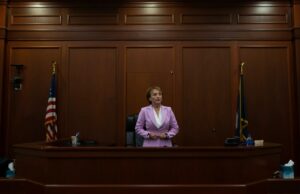How South Carolina Ended Up With an All-Male Supreme Court

When attorneys arrived for oral arguments in South Carolina’s high-profile abortion case last fall, state Supreme Court Justice Kaye Hearn took her seat up front, a ruffly white shirt beneath her black robe, the only woman on the dais. With piercing green eyes, she scanned the courtroom.
A sea of white men jammed one side of the room. Before them, at a wooden table, sat three male attorneys there to argue in favor of the state’s law banning abortion after about six weeks of pregnancy.
On the other side of the room, a group composed mostly of women crowded benches behind a female attorney who had challenged the law.
Even in these polarized times, the starkness of the divide stunned Hearn.
South Carolina’s high court was among the first to hear an abortion law challenge after the U.S. Supreme Court released its Dobbs v. Jackson decision last June, overturning the country’s landmark abortion rights case Roe v. Wade and kicking the combustible issue to the states. Hearn knew the nation was watching. But she didn’t anticipate that the arguments about to begin in that divided courtroom would contribute to an even starker gender divide on the court where she sat.